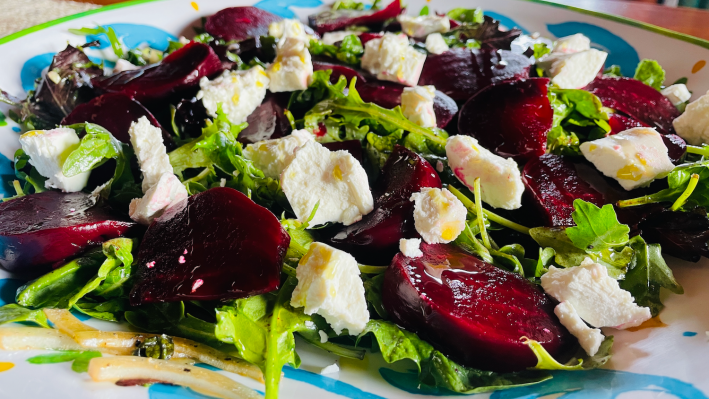There may be no sadder, lower fate for a plant than to become a fad meat substitute. The indignity! The insult! Billions of years of evolution, an impossibly hard-won corner staked out in a harsh and pitiless ecosystem, colors and fragrances and nutrients measured and balanced and arrayed just so and like nothing else—only to be dressed up as a friggin' burger so that some self-punishing American with an aversion to consciously eating vegetables can feel vaguely disappointed by his lunch. It isn't fair.
It's been the noble beet's turn in the barrel, recently. Maybe you've seen this. Beet steaks, things of that nature. I had a beet burger a few weeks ago: a burger with a patty made of cooked beet ground up and mixed with other stuff. It was a fine sandwich, quite tasty in fact. Its worst attribute, by far, was the word "burger" appended to it on the menu. How could you help but hope, or expect, that the first bite of it would remind you of, y'know, a burger? It didn't taste like a burger. It tasted like beets (with other stuff). That's a fine way to taste. It shouldn't have to be graded as a burger, or measured against a burger. I felt, on the beet's behalf, like one of those celebrities who starts in on the "Do you know who I am????" when they get told there aren't any tables available at the restaurant. This is the beet we're talking about, here! Nobody puts Beet in the corner!
I'm overstating things here, because it's fun to do that. Eat what you want. If you see the beet burger on the menu and think "Dang, I bet that's tasty," go right ahead and order it. Order the beet, uh, tenderloin or whatever, on the unlikely promise that the beet's thick juiciness can recall for you the bloody satisfaction of a medium-rare steak. It's fine. Maybe you do not want to eat meat anymore. That is admirable and I hope the beet makes it easier for you.
But I also hope that you will allow the poor beet, some time when you are not dragooning it into a sad and inadequate theatrical performance of the attributes of some whole other thing, an opportunity to taste good as a beet. The beet deserves this. It could have been anything, and it worked hard to become the beet, instead of a wad of cow. Nothing else in all the world is like it.
With that in mind, let's roast some beets in the oven. Beets are not really in season right now, as I'm writing this—strictly speaking they are winter produce. But like most of the root-foods, they can be found pretty much year-round, and frankly this is not a tomato type of deal; they are pretty much just as good in July as in January. In any event thanks to the nature of the internet these instructions likely will still be around the next time beets are in season, if you want to be a stickler about eating seasonally.
Roasting is my favorite way to cook beets. Others boil or steam them, but I find those methods dilute their flavors, whereas roasting concentrates them. Peeled and sliced and eaten, a roasted beet is silky and sweet, earthy and pleasantly heavy; the temptation is to say that it is meaty, but as we have discussed that is an insult to the beet. It is not like meat; it is like a beet. It is beety.
Roasting beets is very easy and straightforward. The whole rest of this blog could be like two paragraphs. Therefore, in the interest of giving you more blog for your subscription dollars, down below the instructions for roasting beets I will throw in some advice for a good thing to do with them once they are roasted (beyond just, like, eating them as they are). But first, the roasting. Let's do it.
You will need some raw beets. In most of the grocery stores and supermarkets where I encounter raw beets, they are sold in bunches with their stalks and leaves attached; a typical bunch has three or four beets in it, or maybe five if the beets are very small. I like a nice (relatively) big beet: A big beet simplifies things. If you can get three beets that are the size of baseballs, you will almost certainly have at least enough roasted beet for any plausible application intended to feed five or fewer people, possibly verging on too much, but certainly not too little. Unless you are making borscht, which you are not. I have no idea how much three baseball-sized beets will weigh.
In any case, wash each beet under a cold tap. If they're dirty, and they probably are, maybe scrub them with the kind of brush you'd use to clean stubborn gunk off of a dish. A good rule for preparing a beet for roasting is not to give its internal moisture too many avenues for escape; with this in mind, trim the stems off your beets, but like an inch or an inch-and-a-half up from the actual beet itself. Likewise, your beets probably have their weird little roots dangling down from their bottom end; leave these on, for now, for the same reason.
You will need an apron, or a shirt that you do not mind staining forever. Beet juice is an impossibly gorgeous color, and it will stain the damn shit out of any cloth that it touches. It will also stain a wooden cutting board, if you use one of those later on when you get around to peeling and trimming the roasted beets. Personally I am very happy to own a nice wooden chopping block that I take reasonably good care of; I even rub it with mineral oil more-or-less regularly, to keep it shiny and smooth and to keep its surface un-warped. I do not cut or handle beets on this nice wooden block, because I do not want it to forever look as though it has been the host site of a murder. If you have a plastic, acrylic, or composite cutting board, the kind that is dishwasher safe, I recommend using that for all of your beet violence.
You will need some aluminum foil. When each beet is clean and trimmed like we just went over in the previous paragraph, wrap it loosely but completely in aluminum foil. You'll need a foil-lined cookie sheet or roasting pan; when the beets are clean and trimmed and wrapped in foil, plunk 'em on that sheet or pan. You'll need an oven. Why? What will you do with it? Will you throw Hansel and Gretel into it and listen to their screams? For answers to these questions, you must read on.
Preheat your oven to 400 degrees. (In summer I recommend doing all of this in the morning, before the day heats up; you can deploy the roasted beets later on, during the hot part of the day, cool or at room temperature.) When it is 400 degrees, slide the pan with the wrapped beets on it into the oven, and set a timer for an hour. That was like 99.9 percent of the work, right there. An hour from now the timer will go off; you will extract the pan from the oven, carefully unwrap one beet just enough to expose its flesh, and you will poke a fork into it. If the fork stabs down to the middle of the beet smoothly and easily, with only a token resistance, the beet is done. If the fork does not do that, but rather pushes the beet all over the place because the beet is still hard down in there and resisting the fork's efforts, then the beet is not done. If the beet screams horribly, a bone-chilling and bloodcurdling mixture of raw pain and alien rage, and thrashes around inside its foil prison, taking on new and nightmarish shapes in its frenzy and wrath, buddy, that is what the hell they call a dang You Problem.
Check each beet for doneness and/or eldritch evil. Probably the beets are done after the hour is up. If they are particularly large beets, they might not be done yet; in this case, re-wrap them and sock them back in the oven for another 20 minutes. Only the very largest or evilest of beets will not be fully cooked by then.
When the beets are done, simply take the pan out of the oven, turn the oven off, and let the beets sit on the counter, still wrapped, for half an hour or so. This is so they can cool. A nice thing happens while they're doing this; if you have ever roasted bell peppers, you might even have anticipated it. They will steam their own skins loose. That way when you unwrap them after that half-hour of resting, you can peel them by hand, simply by sliding their skins off with minimal pressure from your thumbs. This is very satisfying, unless the beets are still scalding hot, in which case it is in fact quite painful. (If they are scalding hot, please allow them to cool some more.) Once the beets are peeled, hack off their stems and their roots. They should now look like spheres that are flattened at the poles.
That was it. That was roasting beets. You did it!
A nice thing to do with your roasted beets is to slice them into wedges, like in the photo up there, and use them in a salad. Arugula is a popular salad green to pair with beets, for good reason: Its peppery tartness matches well with the beet's sweetness. But the beet is a fine companion for a wide variety of salad greens, including some, like radicchio, that can fit a deep-pink theme, if that is how you would like to roll. Feel free to experiment, or to grab the baloney "spring mix" greens in the sealed bag at the supermarket. It will be fine.
Many restaurant beet salads pair the beets with soft goat cheese, also for good reason, namely that soft goat cheese is extremely friggin' good. If you can score some walnuts, your roasted beets will be very glad to make their acquaintance; if you are not afraid of making your salad very sweet, these can be candied walnuts. You can throw in some thin-sliced raw onion or shallot for some sharp acidity. Toss the greens and the onion with a drizzle of good olive oil and freshly ground black pepper and maybe a squirt of fresh lemon, or a very modest drizzle of some good syrupy balsamic vinegar; then scatter the beets, nuts, and goat cheese over the top, and drizzle just a little more olive oil on there.
Here, sorta like this:

Good. A very good salad, and a nice showcase for your beets.
You can also just, like, eat the roasted beets! Drizzle them with olive oil, sprinkle them with salt, go to town. Or just eat them plain. They're delicious: hearty and luscious, indecent with juice, sweet but also somehow pleasantly redolent of garden soil. I can see you thinking of calling them meaty. I see your mind. Don't do it! I won't stand for it.






